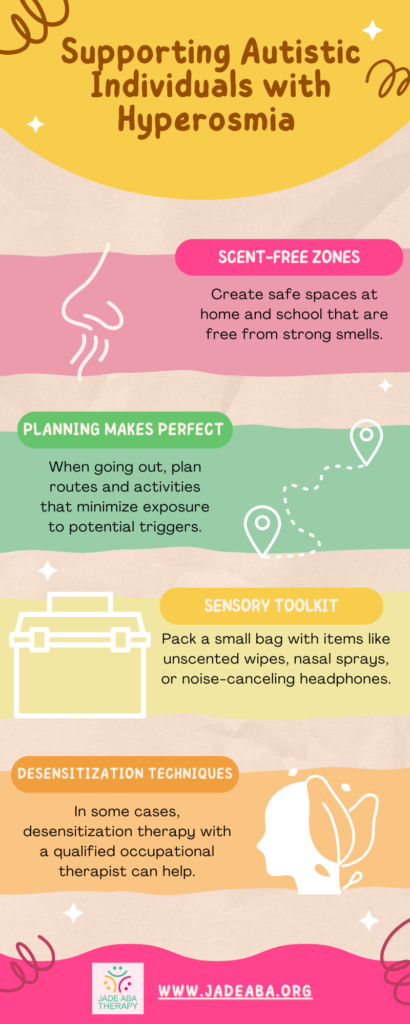Our sense of smell plays a big role in how we experience the world around us. It can warn us of danger (like smoke!), trigger happy memories (freshly baked cookies!), and even influence our social interactions. But for people on the autism spectrum, things can be a little different.
They may find themselves on either end of the smell spectrum – either noticing scents much less than others or being super sensitive to even faint odors. This sensitivity can also fluctuate depending on their mood and energy levels.

The science behind this is fascinating. Researchers are finding that autistic brains process smells differently than neurotypical brains. For instance, they might use different brain regions to distinguish familiar people from strangers based on scent alone!
This heightened sense of smell can sometimes be overwhelming, especially in crowded places or around strong perfumes. Understanding how autism affects smell sensitivity is crucial. It can help us create more supportive environments for autistic individuals.
The Science of Smell Sensitivity
Our sense of smell, also known as the olfactory system, is a powerful tool that helps us navigate the world. It’s like a secret code, with each odor carrying a unique message that our brains can interpret. But for people on the autism spectrum, this code can be a little different.
Lower Sensitivity
Imagine a world with muted smells. Some autistic individuals experience this, where scents seem fainter or less noticeable. This can be a plus side in situations filled with unpleasant odors, but it can also be a safety hazard. For instance, they might not smell burning food.
Higher Sensitivity
On the other hand, some autistic people have a super sniffer superpower! They can pick up on scents that others miss entirely. This can be wonderful when it comes to detecting delicious cooking or fresh flowers, but crowded spaces filled with perfumes can become unbearable.
Modern Research on The Topic
Recent research is helping us understand why some autistic people experience such extremes in smell sensitivity. Studies show that autistic individuals use different brain regions to identify familiar and unfamiliar people based on their scent, compared to people without autism.
Interestingly, it also seems that social information we unconsciously pick up from smells might be processed differently by autistic people. For instance, a study found that men with autism reacted differently to the sweat of skydivers, which might contain a “fear scent.”
These findings are exciting because they suggest that scents could potentially be used in autism therapies. Imagine a familiar scent having a calming effect or certain odors being incorporated into tasks to improve diagnosis or treatment.
Researchers are also looking into how exposure to different scents might influence how well autism therapies work. It’s a fascinating area of research that could unlock new ways to support people on the autism spectrum.

Impact and Support
For someone with hyperosmia, entering a room can be a sensory overload. The intense smells can trigger headaches, nausea, and even dizziness. It can also make it difficult to focus and concentrate, hindering participation in school, work, or social activities.
Mealtimes can become stressful for those with hyperosmia. The smell of certain foods, even ones considered pleasant by others, might be overpowering or unpleasant. This can lead to picky eating habits or even a reluctance to eat altogether.
Public spaces like grocery stores and restaurants can be challenging to navigate due to the abundance of smells. This can lead to social isolation as individuals with hyperosmia may avoid situations where they anticipate overwhelming sensory experiences.
Here are some ways to support someone with hyperosmia:
- Communication is Key: Talk openly about their sensitivities and work together to identify triggers.
- Scent-Free Zones: Create safe spaces at home and school that are free from strong smells. Opt for unscented cleaning products, air fresheners, and laundry detergents.
- Planning Makes Perfect: When going out, plan routes and activities that minimize exposure to potential triggers. Consider less crowded times to visit stores or restaurants.
- Carry a Sensory Toolkit: Pack a small bag with items like unscented wipes, nasal sprays, or noise-canceling headphones to offer relief in overwhelming situations.
- Desensitization Techniques: In some cases, desensitization therapy with a qualified occupational therapist can help individuals gradually build tolerance to specific smells.
Building Confidence and Independence
Beyond creating a supportive environment, it’s crucial to empower individuals with hyperosmia to manage their sensitivities. Teaching them coping mechanisms like deep breathing exercises or mindfulness techniques can equip them to handle unexpected sensory experiences.
The Takeaway
Living with hyperosmia can be challenging, especially if you’re autistic, but there are ways to manage it. Imagine walking into a store filled with perfumes and cleaning products – that’s what everyday situations can feel like for someone with hyperosmia.
If you know someone who struggles with this, a little understanding can go a long way. Try to be mindful of strong scents like perfumes or colognes when you’re around them. Even simple things like offering sugar-free mints can help them feel more comfortable.
Our sense of smell plays a big role in how we experience the world around us. It can warn us of danger (like smoke!), trigger happy memories (freshly baked cookies!), and even influence our social interactions. But for people on the autism spectrum, things can be a little different.
They may find themselves on either end of the smell spectrum – either noticing scents much less than others or being super sensitive to even faint odors. This sensitivity can also fluctuate depending on their mood and energy levels.
The science behind this is fascinating. Researchers are finding that autistic brains process smells differently than neurotypical brains. For instance, they might use different brain regions to distinguish familiar people from strangers based on scent alone!
This heightened sense of smell can sometimes be overwhelming, especially in crowded places or around strong perfumes. Understanding how autism affects smell sensitivity is crucial. It can help us create more supportive environments for autistic individuals.
The Science of Smell Sensitivity
Our sense of smell, also known as the olfactory system, is a powerful tool that helps us navigate the world. It’s like a secret code, with each odor carrying a unique message that our brains can interpret. But for people on the autism spectrum, this code can be a little different.
Lower Sensitivity
Imagine a world with muted smells. Some autistic individuals experience this, where scents seem fainter or less noticeable. This can be a plus side in situations filled with unpleasant odors, but it can also be a safety hazard. For instance, they might not smell burning food.
Higher Sensitivity
On the other hand, some autistic people have a super sniffer superpower! They can pick up on scents that others miss entirely. This can be wonderful when it comes to detecting delicious cooking or fresh flowers, but crowded spaces filled with perfumes can become unbearable.
Modern Research on The Topic
Recent research is helping us understand why some autistic people experience such extremes in smell sensitivity. Studies show that autistic individuals use different brain regions to identify familiar and unfamiliar people based on their scent, compared to people without autism.
Interestingly, it also seems that social information we unconsciously pick up from smells might be processed differently by autistic people. For instance, a study found that men with autism reacted differently to the sweat of skydivers, which might contain a “fear scent.”
These findings are exciting because they suggest that scents could potentially be used in autism therapies. Imagine a familiar scent having a calming effect or certain odors being incorporated into tasks to improve diagnosis or treatment.
Researchers are also looking into how exposure to different scents might influence how well autism therapies work. It’s a fascinating area of research that could unlock new ways to support people on the autism spectrum.
Impact and Support
For someone with hyperosmia, entering a room can be a sensory overload. The intense smells can trigger headaches, nausea, and even dizziness. It can also make it difficult to focus and concentrate, hindering participation in school, work, or social activities.
Mealtimes can become stressful for those with hyperosmia. The smell of certain foods, even ones considered pleasant by others, might be overpowering or unpleasant. This can lead to picky eating habits or even a reluctance to eat altogether.
Public spaces like grocery stores and restaurants can be challenging to navigate due to the abundance of smells. This can lead to social isolation as individuals with hyperosmia may avoid situations where they anticipate overwhelming sensory experiences.
Here are some ways to support someone with hyperosmia:
- Communication is Key: Talk openly about their sensitivities and work together to identify triggers.
- Scent-Free Zones: Create safe spaces at home and school that are free from strong smells. Opt for unscented cleaning products, air fresheners, and laundry detergents.
- Planning Makes Perfect: When going out, plan routes and activities that minimize exposure to potential triggers. Consider less crowded times to visit stores or restaurants.
- Carry a Sensory Toolkit: Pack a small bag with items like unscented wipes, nasal sprays, or noise-canceling headphones to offer relief in overwhelming situations.
- Desensitization Techniques: In some cases, desensitization therapy with a qualified occupational therapist can help individuals gradually build tolerance to specific smells.
Building Confidence and Independence
Beyond creating a supportive environment, it’s crucial to empower individuals with hyperosmia to manage their sensitivities. Teaching them coping mechanisms like deep breathing exercises or mindfulness techniques can equip them to handle unexpected sensory experiences.
The Takeaway
Living with hyperosmia can be challenging, especially if you’re autistic, but there are ways to manage it. Imagine walking into a store filled with perfumes and cleaning products – that’s what everyday situations can feel like for someone with hyperosmia.
If you know someone who struggles with this, a little understanding can go a long way. Try to be mindful of strong scents like perfumes or colognes when you’re around them. Even simple things like offering sugar-free mints can help them feel more comfortable.
Sources:
https://autismunderstood.co.uk/autistic-differences/sensory-smell
https://thepolyphony.org/2023/06/13/olfactory-overload-knowing-the-neurodivergent-nose